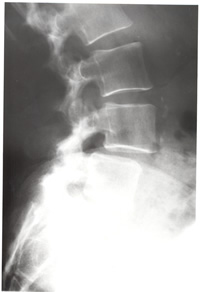HISTORY
This 50-year-old female patient presents with a six-month history of lower back pain without peripheral radiation.
DISCUSSION
Degenerative spondylolisthesis (Type III) has been referred to as a “pseudospondylolisthesis” by Junghans, to differentiate spondylolisthesis with an intact neural arch from those with a true defect of the neural arch.1 Macnab2 prefers the phrase “spondylolisthesis with an intact neural arch,” which is a more accurate description. Thus, degenerative spondylolisthesis is another type of nonspondylolytic spondylolisthesis.
Degenerative spondylolisthesis is approximately ten times more common at L4 than at the L3 or L5 vertebrae and is six times more common in females sixty years of age or older, compared with males of the same age.3 Type III is rare in persons younger than fi fty years of age. Degenerative spondylolisthesis is three times more common in blacks than in whites, with no adequate explanations for these sexual and racial disparities. Finally, degenerative spondylolisthesis is four times more likely to be found in association with a sacralized fi fth lumbar vertebra.1,2
 Figure 1. Observe the 20 percent anterior
Figure 1. Observe the 20 percent anterior
displacement of L4 upon L5 without pars defects.
There is underlying discogenic spondylosis and
posterior facet arthrosis. This represents a
degenerative spondylolisthesis (pseudospondylolisthesis).
The mechanisms of displacement are thought to involve a combination of zygapophyseal joint arthrosis, disc degeneration, and remodeling of the articular processes and pars.2 An increase of the “pedicle-facet angle” has been noted in the degenerative type of spondylolisthesis.1 This angle, formed by the long axis of the pedicle (or vertebral root) at its intersection with the long axis of the articular pillar, indicates the more horizontal alignment of the degenerative zygapophyseal joints as seen on the lateral radiograph and demonstrates the overriding of the articular surfaces.1
|
The Three F‘s of Degenerative Spondylolisthesis |
| Female |
| Four (L4) |
| Above Forty years |
Several explanations have been proposed for degenerative spondylolisthesis occurring with such great frequency at the L4 level. Allbrook has stated that the greater mobility of L4 due to the sagittal orientation of the facets at the L4/L5 level may explain the unusual frequency of degenerative spondylolisthesis at the L4 level. Additionally, the fi rmly attached, normal lumbosacral joint may place increased stress on the L4/L5 intervertebral joints, ultimately leading to hypermobility and degeneration of the articular triad.3 No greater than 25 percent anterior displacement of the L4 vertebral body occurs, and the majority involves 10 to 15 percent displacement.1,3
Dr. Terry R. Yochum is a second generation chiropractor and a Cum Laude Graduate of National College of Chiropractic, where he subsequently completed his radiology residency. He is currently Director of the Rocky Mountain Chiropractic Radiological Center in Denver, Colorado, and Adjunct Professor of Radiology at the Southern California University of Health Sciences, as well as an instructor of skeletal radiology at the University of Colorado School of Medicine, Denver, CO. Dr. Yochum can be reached at 1-303-940-9400 or by e-mail at [email protected].
Dr. Chad J. Maola is a 1990 Magna Cum Laude Graduate of National College of Chiropractic. Dr. Maola is a Chiropractic Orthopedist and is available for post-graduate seminars. He may be reached at 1-303-690-8503 or e-mail [email protected].
References:
1. Yochum TR, Rowe LJ: Essentials of Skeletal Radiology, 3rd ed., Lippincott, Williams & Wilkins, Baltimore, Maryland, 2005.
2. Macnab I: Spondylolisthesis With an Intact Neural Arch – So Called Pseudospondylolisthesis, J. Bone Joint Surg (BR) 32:325, 1950.
3. Rosenberg, MJ: Degenerative Spondylolisthesis, Clin Orthop 1976.117:112, 1976.
